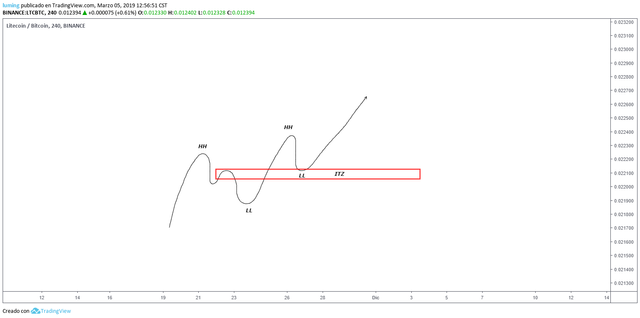
Hello steemians!!. This is my first post of a series of publications where I will teach the knowledge that I have been acquiring over time on the TA, I will try to make the topics easy to learn for those who are starting to be traders. As the first topic I have chosen the structure of the market because it is something basic and very necessary to understand if we want to obtain profitability in our operations.
In the market there are 3 types of different structures:
1.- Bullish.
2.- Bearish.
3.-Sideways.
Each one of them has a different way of trading, in this topic I will deal with the bullish structure, the bearish structure will be the next post and the lateral structure I will deal with it in another topic on how to trade ranges.
Bullish structure.
The bullish structure is made up of a series of higher highs and higher lows, it sounds simple, however, many traders do not know how to identify well at what time between an HH (higher high) and an LL (lower low) is the best to enter into long or leave the trade.

In the image above we see how a bull structure is composed, seen from its simplest form, we have 2HH and 2 LL, when a HH occurs there has to be a correction after a consolidation below the resistance that weakened the strength of the bulls to move forward, this correction is composed of 3 points (ABC), we can see it in the image inside the red box, that high that is formed in point B becomes the ITZ (important trading zone) for traders, once the range occurs in point C of the correction and we see that the price breaks that area, a pullback is made above and the test as support, the bulls will be happy to continue in favor of the trend and therefore the price begins to rise. When the ITZ is broken, the pullback is done because the price meets again the resistance of the previous HH and then retreats but forming an LH (higher low) that convinces the bulls that the trend is not over yet and that it is time to go for more profits. In some cases we will even see that after the break of the ITZ point the price forms a new HH and then performs the pullback and in other cases that the price does not make the pullback and goes up to reach the high target for the bulls and then begins to go down, as traders we have to make important decisions in the market at every moment, at the end of the day it is our money that we put at risk by trading, therefore, regarding the break of the ITZ we will choose whether or not to wait for the pullback, the probabilities come into play in this decision, there is no more to do at that moment, risk and enter the bull candlestick and wait for it to continue rising or we wait for a correct testing of the support to continue long later.

In the image above we see a clear example of what happens in the market in a real situation, when there is a correction after the first HH, the candles go down in 3 points ABC, that high of point B becomes an ITZ that I did not indicate in the graph (excuse me for that :)), but that they can identify only with the horizontal line (I use the rectangles to completely enclose the point and decide to enter or leave the operation with more precision), when continuing lowering and forming the point C that will also be our LL of the structure, the price stops forming a range and then begins to rise, in that bullish movement a new ITZ is produced that will serve us as support in the following correction as we see in the image of above indicated with the blue rectangle, as the next move the price rises meets the resistance, the pullback is produced towards the ITZ point tests it correctly (the candles are kept above and the wicks locate support), the price continues to rise, a new HH, very short that could deceive many bulls, the price consolidates below the resistance and a new ABC correction begins, history repeats itself, a new ITZ is formed (indicated in the image with a red rectangle), the point C is produced in the blue ITZ, tests it correctly and then the price begins to rise to the red ITZ point, forming an HL (lower high), the pullback is produced and at that time the candles are currently in this chart, it seems to be consolidating well, starting to rise is very possible that the break occurs with force of the ITZ point and the price rises quickly, but it could also happen that the price touches the bottom of the red rectangle and drops precipitously, this is where traders should apply their reasoning and think that every time there has been a pullback in the figure the LH have been higher and every time the price found resistance forming an HH have been weaker, therefore there is more probability that the bullish break will occur.

In the image above we see the figure only with the points HH and LL.
The price would continue the bullish structure until it finds an ITZ point produced during the past bearish structure.
This would be all about a bullish structure, as you see everything makes sense, locating the ITZ points is the most important thing as these areas will be our moments of entering or leaving a trading operation. I hope that this will serve you as much as it has served me in practice, for the next topic we will see the bearish structure, it is very similar, only the ITZ locations change, I will explain them later :).
If you have any questions on the subject, don't hesitate to let me know, I'll try to help in any way I can ;)
Sponsored ( Powered by dclick )
Check out my review on youtube about cryptocurrency ...



